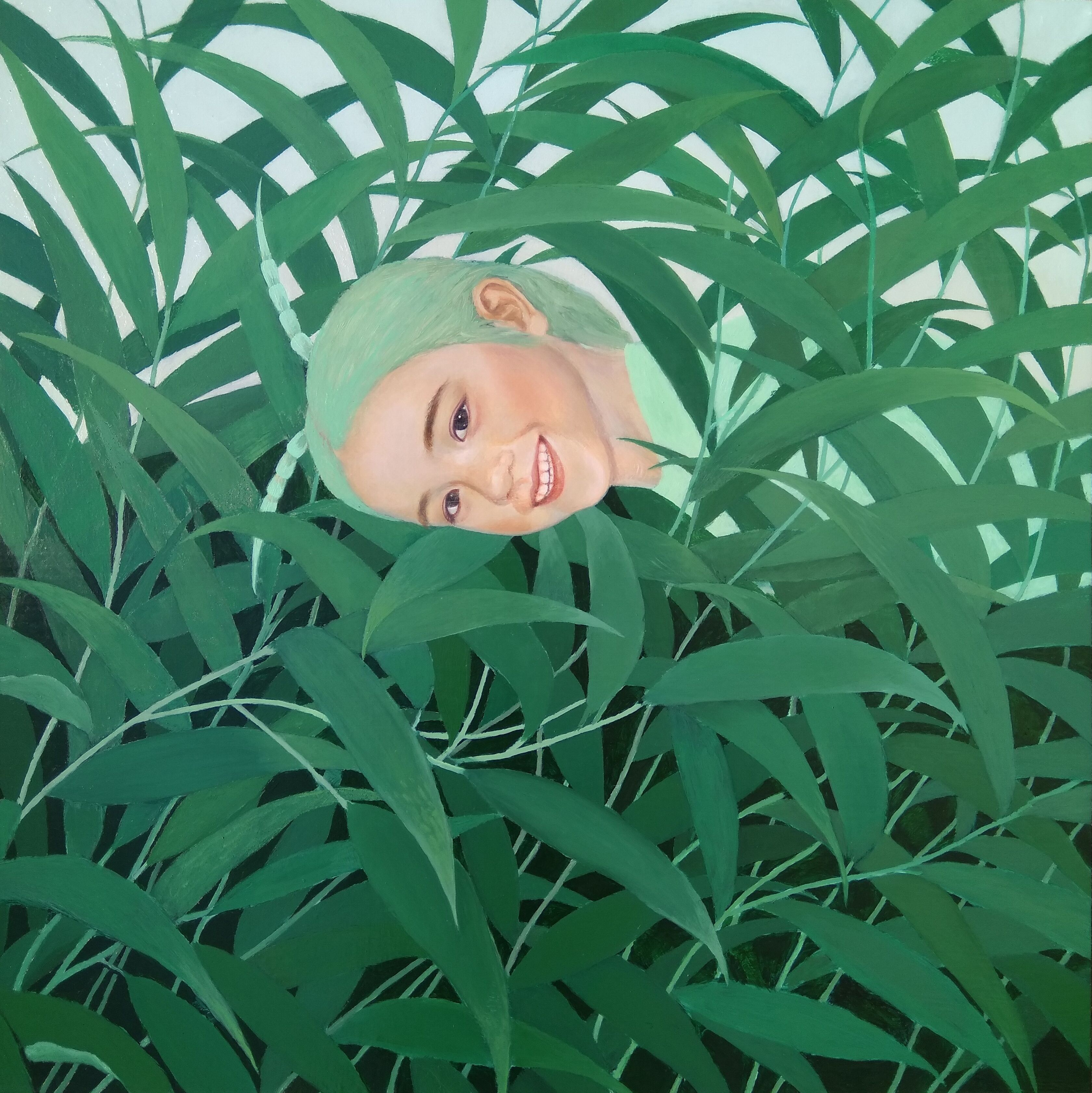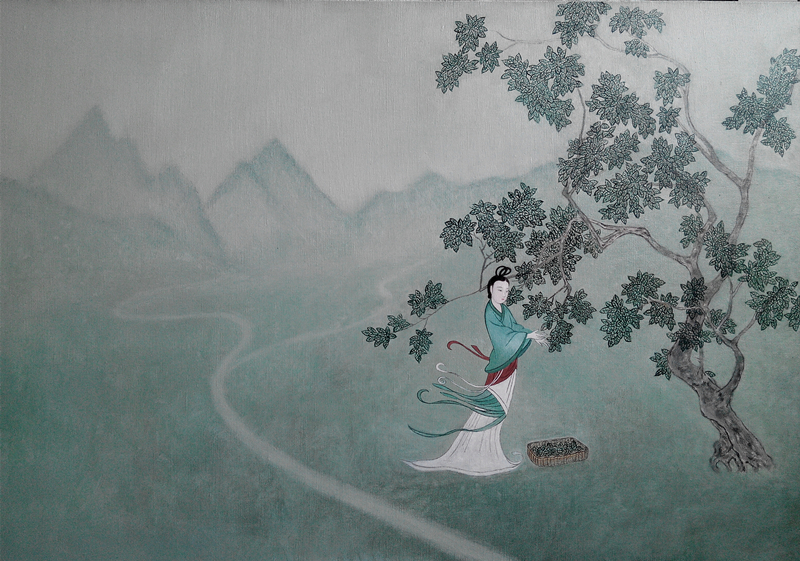2019 ”夏梦” 双人展 颜小倩专访 | Interview with Wang Qifeng
1. 您的作品大多取材于古老的《诗经》,您为何对《诗经》情有独钟?
颜小倩:我认为思想与情感是一件作品的灵魂。如何做到避免情感狭隘和思想偏执,目前我的认知是去解读当下前沿的思想以及传统遗留下来的文化。我很幸运地活在信息全球化的今天,每天我都能了解到新的东西, 然而能经过几千年洗礼后仍留存于世并成为经典的东西必然值得研读。《诗经》作为经典已经被研究了两千多年,足可见其在中国文学史上地位的崇高。我在研读的过程愈发被文字承载的意志与情感所打动。于是创作了部分相关作品。我希望能有更多的人去读《诗经》,它定会赠予大家从现实生活中无法获得的感受。

Most of your artworks are based on the earliest ancient poem collection《Book of Songs》. Why do you keen on 《Book of Songs》? How does it inspire modern people’s life?
Yan Xiaoqian: I think the soul of one piece of artworks is emotions and thoughts. At present, the only way to avoid being narrow and based in thoughts is to interpret the most up-to-date ideas and to inherit the national cultural heritage. I am very lucky to live in the era of globalization, so that I can learn new things every day.

Nevertheless, it is necessary to study the classics that have survived and remained throughout thousands of years. As a classic literature, the Book of Songs has been studied for more than two thousand years, which proves its high values and status in the history of Chinese literature. I was so touched by the will and the affection from these poems while reading and studying the Book of Songs. Therefore, it inspires me to a new series of works.

I hope more people will be encouraged to read and to understand the Book of Songs, I believe it will touch you with the feelings and affections that we can hardly get from real life.

2. 您的新作“夏虫”与其他以诗诉情,哀而不伤的作品不同,给我们带来了阳光与温暖,纯真与快乐。能与我们谈谈这两幅作品的创作意图吗?
颜小倩:‘夏虫不可语冰’是比喻人的眼界局限,见识浅陋。可夏虫一生活在温暖与阳光里,难道这不正是世界对它的偏爱吗?它们是没有阴暗面的孩子,拥有着最初最纯粹的美好。它们只走过三季而人生却要经历过无数个四季,曾陷入过黑白是非、也见过人性的光明与黑暗。然而要成为一个始终心怀善意的人,最重要的一点是生命中怀藏着永远的光明。《夏虫》这个系列我还会继续画下去,愿走过风雪冰霜的人们,一直记得自己曾是夏虫的模样,永远拥有勇气和真心,永远天真明亮。

Your latest paintings“Summer Spirit” is quite different from other artworks in terms of the way of expression. It brings us sunshine and warmth, innocence and happiness. Can you tell us why?
Yan Xiaoqian: One Chinese proverb saying “Don’t speak of ice to insects that live only one summer.” to describes people have limited visions and insights. In the favor of the nature, the caterpillars live in warmth and sunshine all their lives. They are the children without shadows who keep the purest beauty. They only go through three seasons while we have to go through many “four seasons”. However, if we want to become a kind person with a beautiful mind, after seeing the light and darkness of human nature, the most important thing is to be have eternal light inside your heart. I will carry on the series of “Summer Spirit”. I wish those who have walked through snow and ice could always remember the spirit when they used to be in the summer, keep their courage, sincerity and will shine forever.

3. 本次参展的《芙蓉图》构思很巧妙,东方水墨的意境与西方油画的强烈色彩浑然一体,毫无违和感。画中女子的头饰也非常引入注目,据说这是中国苗族妇女的古老头饰,能与我们分享一下创作灵感吗?
颜小倩:《芙蓉图二》的人物形象的创作灵感来自苗族妇女长角苗的发饰造型。长角苗是迄今为止保存得相当完整的以长角头饰为象征的一种古老而独特的苗族文化传统。其独特之处在于妇女头顶上戴有形似长角的大木梳,角上绕有2-4公斤重的头发。用来盘成巨大发髻的是亡故祖先的头发,盘得越大则越美。长角苗的历史与回忆都写在头发上,母亲每天梳头时把掉下的头发编织起来,作为嫁妆传给女儿,代代相传。震撼于他们对生命与死亡的敬畏,一头长发盘着的是生生不息的文化传承。
《芙蓉图一》中我使用了荷花盘于发的形象。国人爱荷已达千年以上的光景,荷花被赋予很多人格上的魅力和文化内涵,至今盛而不衰。画这个题材的时候很自然地就联想到两者的相通之处。

The “Lotus” series in this show is rather subtle and beautiful. The artistic conception of oriental ink wash is in great harmony with the vibrantcolor of western oil paintings. The women’s headwear in the painting is also very noticeable. It is said that this is the ancient headdress of Miao minority women in China. Can you share your inspiration with us?
Yan Xiaoqian: The headwear from “Lotus No.2” is inspired from Long-horned seedlings. Long-horned seedlings is the symbol of Miao’s unique ancient tradition and culture. This unique feature of long-horned seedlings is that women wear long-horned wooden combs on top of their heads with 2-4 kg of hair around their horns. The hair of the deceased ancestors is used to make huge buns. The larger the buns are, the more beautiful they are. The history and memories are all written in Long-horned seedlings, Mothers weave their fallen hair when they comb their hair every day and pass it on to their daughters as dowry from generation to generation. I am so much impressed by them with the awe of life and death, this hair bun is the endless cultural heritage from life.

As for “Lotus No.1” The Chinese have a preference for Lotus for more than a thousand years, and it is still quite flourishing nowadays, as lotus is always considered as a cultural symbol to represent the good quality and charm in human’s personality. So I used lotus as the hair style that describes the beauty of life.

